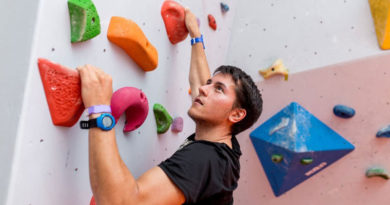Bouldering vs. Top Rope: What is the Difference?
Bouldering and top rope climbing are two popular forms of rock climbing. Bouldering is the practice of climbing short and challenging routes without the use of ropes or other safety equipment. You usually do it on boulder formations or artificial climbing walls. Top rope climbing, on the other hand, involves ascending a route while being secured by a rope. The rope runs from the climber’s harness, through an anchor at the top of the route, and back down to a belayer on the ground.
The main difference between the two is the lack of ropes in bouldering. Bouldering focuses on shorter height of routes and the emphasis is on power and technique rather than endurance. However, top rope climbing offers a high level of safety by the rope. Bouldering is also commonly done indoors or in specialized boulder fields. Top rope climbing can be done both indoors and outdoors on larger rock formations.
Techniques and Gear
Bouldering requires a different set of skills than standard climbing. This is because you must rely on balance, power, and problem-solving abilities to reach the top of the boulder. Boulderers usually wear climbing shoes and chalk to increase their grip.
Top rope climbers use traditional climbing techniques. The belayer provides safety for the climber by controlling the rope. Climbers often wear a climbing harness, helmet, and climbing shoes, and attach the rope with carabiners and quickdraws.
Advantages and Disadvantages
Bouldering allows climbers to concentrate on power and technique while also presenting a mental and physical challenge. It is, however, more dangerous because climbers do not have the safety of a rope.
Top rope climbing is safer than bouldering. However, it still requires a belayer and can be more physically taxing because of the longer routes.
Safety
Bouldering and top rope climbing have different levels of safety. Bouldering is a type of climbing that does not use ropes. It carries a higher level of risk. This is because climbers do not have the safety of a rope to catch them if they fall.
Top rope climbing, on the other hand, uses a rope. The rope increases safety because the belayer can control the rope and assist in catching the climber in the event of a fall.
Physical and Mental Challenges
You will be challenged physically and mentally by both bouldering and top rope climbing. Bouldering emphasizes strength and technique. It requires you to use your balance, strength, and problem-solving abilities to reach the boulder. This type of climbing is physically taxing and provides you with a good workout.
Top rope climbing, on the other hand, takes a distinct set of skills. You must move up the route while being secured by a rope. It can also be physically taxing owing to the longer routes. Both types of climbing present a mental challenge because they require you to plan and solve problems to ascend.
Cost
The cost of bouldering and top rope climbing can vary a lot. Factors, such as gear, location, and whether it is done indoors or outdoors will determine the final cost of your climb. Indoor climbing gyms often charge a fee to use their facilities, which can add up if you climb frequently. Outdoor gear, such as ropes, harnesses, and carabiners, can also be more expensive to purchase. However, you can spread out the cost over time and use it for multiple climbing trips. It’s also important to factor in the cost of transportation to outdoor climbing locations. While both bouldering and top rope climbing can have upfront costs, they can also provide an inexpensive form of exercise and recreation in the long run.
Social Aspect
Both bouldering and top rope climbing offer a social aspect, allowing climbers to enjoy the sport alone or with others. Bouldering is particularly social since climbers frequently collaborate to solve issues and share knowledge. As climbers help one another and share in the experience, this type of climbing can also promote a sense of community.
Even though top rope climbing is less social than traditional climbing, it may still be a collaborative sport between the climber and the belayer, and going on outdoor climbing adventures with friends can be enjoyable and social.
Both types of climbing can be a fantastic opportunity to meet like-minded people and create new connections. The social component of bouldering and top rope climbing ultimately depends on the interests of the individual and the group they choose to be a part of.
Conclusions
Bouldering and top rope climbing are two popular forms of rock climbing that offer unique challenges and experiences for climbers. Bouldering emphasizes strength and technique while also offering a mentally and physically taxing workout. On the other hand, top rope climbing calls for a different set of skills and might be more physically taxing due to longer routes. Both forms of climbing provide a social aspect, allowing climbers to participate alone or with others, and both offer opportunities for physical and mental growth.
Bouldering and top rope climbing can be pricey depending on one’s degree of involvement. However, both can be an inexpensive source of fitness and pleasure in the long run. When deciding between bouldering and top rope climbing, it’s vital to evaluate the level of physical and mental effort, expense, and social component. Regardless of your preference, both types of climbing may be gratifying and exhilarating.




